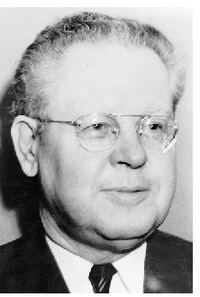Ralph Carr, the man who served as governor of Colorado at the start of World War II, had been largely forgotten for decades. But thanks to an effort by the Asian Pacific Bar Association (APABA) and a biography by journalist Adam Schrager, Carr’s making a comeback in Colorado, and his legacy is finally getting its due, with a fine biography, a stretch of Highway 285 named in his honor, and now, a memorial to Carr’s legacy at Kenosha Pass.
On December 12, representatives of Denver’s Japanese American community, APABA, and CDOT assembled at a scenic overlook just a few hundred feet west of the Kenosha Pass summit on Highway 285 to dedicate the memorial. (Here’s a nice report from the Canyon Courier about the dedication.)
It’s a massive stone tribute engraved with a message that explains the significance of Ralph Carr to Colorado.
A rising star in the Republican Party during the 1930s, Carr was mentioned as a future presidential candidate when he famously became the only Western governor in the months following the bombing of Pearl Harbor to oppose first the harassment, and then the internment of Japanese Americans.
In fact, Carr invited people of Japanese ancestry, in speeches and through a letter published in the Pacific Citizen newspaper of the Japanese American Citizens’ League, to come to Colorado where they would be welcomed. He protested the building of Colorado’s only internment camp near the southeastern town of Granada. He defended the rights of Japanese Americans because of his staunch belief in the US Constitution (which means he wasn’t so charitable on Japanese immigrants, but thought imprisonment of US-born citizens, the children of immigrants, was illegal).
Many believe he destroyed his political future by speaking out to protect Japanese Americans’ civil rights, and he only got to serve one term as governor, under a deluge of hate mail and protests. He lost the governor’s mansion in 1940 by a slim margin, lost a senate race in 1942 and died in 1950 while running agin for governor.
In the immediate postwar years, Denver was one of the most popular destinations for Japanese Americans released from internment camps. They didn’t want to go back to the West Coast where they’d faced racial bigotry and where many families lost all their possessions and businesses. Many headed for Colorado because they’d heard about Carr. Though within a decade, the population of Denver “Japantown” shrank as people did return to California and the Northwest, there was a large and vibrant Japanese community that stretched from the edge of downtown through Five Points all the way to City Park all through the 1950s and into the ’60s.
Sakura Square, the downtown hub of Denver’s Japanese community today, has featured a bust of Carr in its garden plaza since 1976, and there is a more recent bust on the east side of the State Capitol. But it was after the 2008 publication of journalist Adam Schrager’s “The Principled Politician,” a well-written and exhaustively researched biography of the governor, that Carr’s legacy has been re-polished in earnest.
That year, both houses of the state legislature voted unanimously to rename a stretch of Highway 285 from Denver to Kenosha pass as the “Ralph Carr Memorial Highway,” and a few months later Governor Bill Ritter signed a bill to name the new state judicial complex downtown the Ralph L. Carr Justice Center. The dedication of the memorial is icing on the historical cake.
The memorial, which was paid for by funds raised by APABA (under the leadership of now-Denver judge Kerry Hada) and individual donors, sits at a magnifient spot that looks out over the huge flat expanse of South Park (yes, the area that the cartoon lampoons), where Hwy 285 descends from Kenosha Pass and snakes its way eventually to New Mexico. Next to Carr’s memorial is a smaller one that explains the significance of South Park to the Native Americans who hunted there, and to early white explorers who mapped the area: Zebulon Pike in 1806 and JC Fremont in 1844.
Twenty people gathered at the memorial on Dec. 12 for the dedication. Among them were Colorado’s Speaker of the House, who noted that history had proven that Carr was right in defending the constitutional rights of Japanese Americans in the face of the war hysteria of the times.
Judge Kerry Hada credited the Asian Pacific American Bar Association’s Foundation for helping fund the memorial, and added his family’s personal connection to Carr. “I spoke of my Uncle Roy, Auntie Yoshiko, Roy’s younger brother Herb, and their families’ tough trek from Los Angeles to Colorado to escape banishment to an internment camp,” Hada writes in an email.
“I mentioned how Governor Carr welcomed them at the Colorado-New Mexico border. Governor Carr remained true to his word in welcoming Japanese Americans to Colorado, when every other western Governor threatened harm or punishment.”
Here’s the text of the Carr memorial:
RALPH CARR MEMORIAL HIGHWAY
IN COMMEMORATION OF
RALPH L. CARR
GOVERNOR OF COLORADO (1939-1943)
Following the attacks of Pearl Harbor, tens of thousands of Japanese Americans were forcibly sent to internment camps by the federal government. These Americans lost their property, possessions and freedoms unjustly and without due process. Defying overwhelming popular sentiment, Governor Ralph Carr defended U.S. citizens of Japanese ancestry. His convictions were clear:
“When it is suggested that American citizens be thrown into concentration camps, where they lose all privileges of citizenship under the Constitution, then the principles of that great document are violated and lost.”
Governor Carr’s brave and unpopular stand would cost him his political career but earned him the enduring respect of generations of Coloradans.
“…one voice, a small voice but a strong voice, like the voice of a sandpiper over the roar of the surf.” – Minoru Yasui
*This article was originally published in NIKKEI VIEW: The Asian American Blog on December 20, 2010.
© 2010 Gill Asakawa








